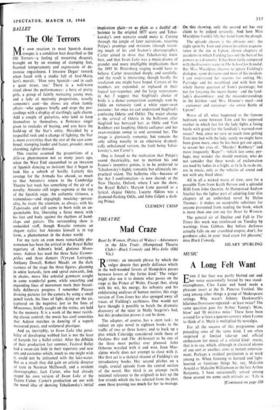BALLET
The Ole Terrors
MY own reaction to most Spanish dance troupes is a condition best described as the Old Terrors—a feeling of mounting disquiet, brought on by an evening of stamping feet, flaunted temperaments and expressions of de- moniac roguishness. I treasure Degas' remark when faced with a studio full of lose-Maria Sert's murals: 'How very Spanish—and in such a quiet street, too.' There is a well-worn ritual about the performances: a bevy of pretty girls, a group of faintly menacing young men, and a lady of matronly proportions, usually someone's aunt—the shows are often family affairs—who appears briefly and stops the pro- ceedings with a display of startlingly agile charm. Add a couple of guitarists, who tend to keep themselves to themselves, a flamenco singer given to roulades of baying, and you have the build-up of the Star's entry. Heralded by a respectful rush and a change of lighting, the Star is more everything than the rest of the cast com- bined; stamping louder and faster, prouder, more charming, tighter dressed.
This routine assumed the proportions of a déjà-vu phenomenon not so many years ago, when the West End succumbed to an invasion of Spanish dancing so insistent that it began to look like a suburb of Seville. Latterly this revenge for the Armada has abated, so much so that Antonio's return to the Cambridge Theatre last week has something of the air of a novelty. Antonio still reigns supreme at the top of the Spanish steps. An authentic virtuoso, a tremendous—and engagingly mocking—person- ality, he rivets the attention, as always, with his Zapateado, and still seems to burn with an un- quenchable fire, liberating a fierce music with his feet and body against the rhythms of hand- claps and guitars. The surrounding show is undecided stuff, though Rosario remains an elegant stylist; but Antonio himself is in top form, a phenomenon in the dance world.
For my taste an even more remarkable phe- nomenon has been the arrival in the Royal Ballet repertory of Ashton's brief, glorious Mono- tones. Ashton has used the three Satie Gymno- pedies and three dancers (Vyvyan Lorrayne, Anthony Dowell, Robert Mead); on the dark vastness of the stage the three figures, gleaming in white leotards, turn and spiral outwards, link in chains, move like celestial gymnasts caught in some wonderful game, while uncurling and expanding lines of movement mark their beauti- fully deliberate progress. I remember Picasso drawing pictures for the camera by using a small pencil torch, the lines of light, dying on the air, captured on the negative; just so the lines of Monotones, briefly caught on the retina, are held by the memory. It is a work of the most ravish- ing classic control; the music has cool sonorities that Ashton matches in dancing of a superb measured peace, and sculptural plastique.
And so, inevitably, to Swan Lake (the possi- bility of developing webbed feet is not the least of hazards for a ballet critic). After the debacle of their production last summer, Festival Ballet had a swan-size hole in their repertory and new sets and costumes which, much as one might wish it, could not be jettisoned with the lake-water. But as a result they did gain an artistic director of taste in Norman McDowell, and a resident choreographer, Jack Carter, who had already staged his own version of Swan Lake at the Teatro Colon. Carter's- production set out with the novel idea of showing Tchaikovsky's initial -inspiration plain—or as plain as a dutiful herence to the original 1877 score and Tchai- kovsky's own scenario could make it. Cutting through the jungle of later accretions, rejecting Petipa's prunings and revisions (though retain- ing much of his and Ivanov's choreography), Carter aimed to show that Tchaikovsky knew best, and that Swan Lake was a music-drama of grander and more intelligible implications than the 1893 St. Petersburg staging would have us believe. Carter researched deeply and carefully, and the result is interesting, though hardly the revelation one might have hoped. Certain of the numbers are expanded, or replaced in their logical key-sequence, and the large restorations in Act 3 suggest that Siegfried's choice of bride is a dance competition seemingly won by Odile on virtuosity (and a white super-swan costume: for once we can understand Siegfried's confusing Odette and Odile). The major change
• is the arrival of Odette in the ballroom after Siegfried has betrayed her; as Odile and Von Rothbart exit laughing, Odette collapses and her swan-maidens sweep in and surround her. The image is gloriously romantic, but remains the only telling novelty in an otherwise dramati- cally unbalanced version, the fault being Tchai- kovsky's, not Carter's.
• One is forced to the realisation that Petipa's sound theatricality, not to mention his and Ivanov's inventive genius, is to be preferred to Tchaikovsky's highly romantic but ultimately im- practical vision. The ballerina role—because of the Act 3 confrontation—is now shared; at the New Theatre, Oxford, where I saw the show, the Royal Ballet's Maryon Lane guested as a lyrical, elegiac Odette, Lucette Aldous was a diamond-flashing Odile, and John Gilpin a dash- ing Prince.
CLEMENT CRISP


































 Previous page
Previous page